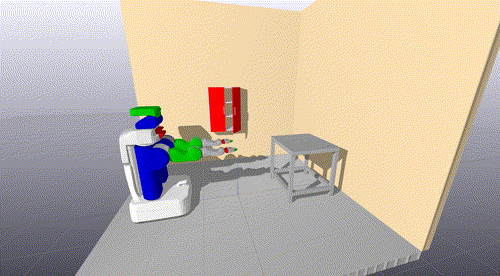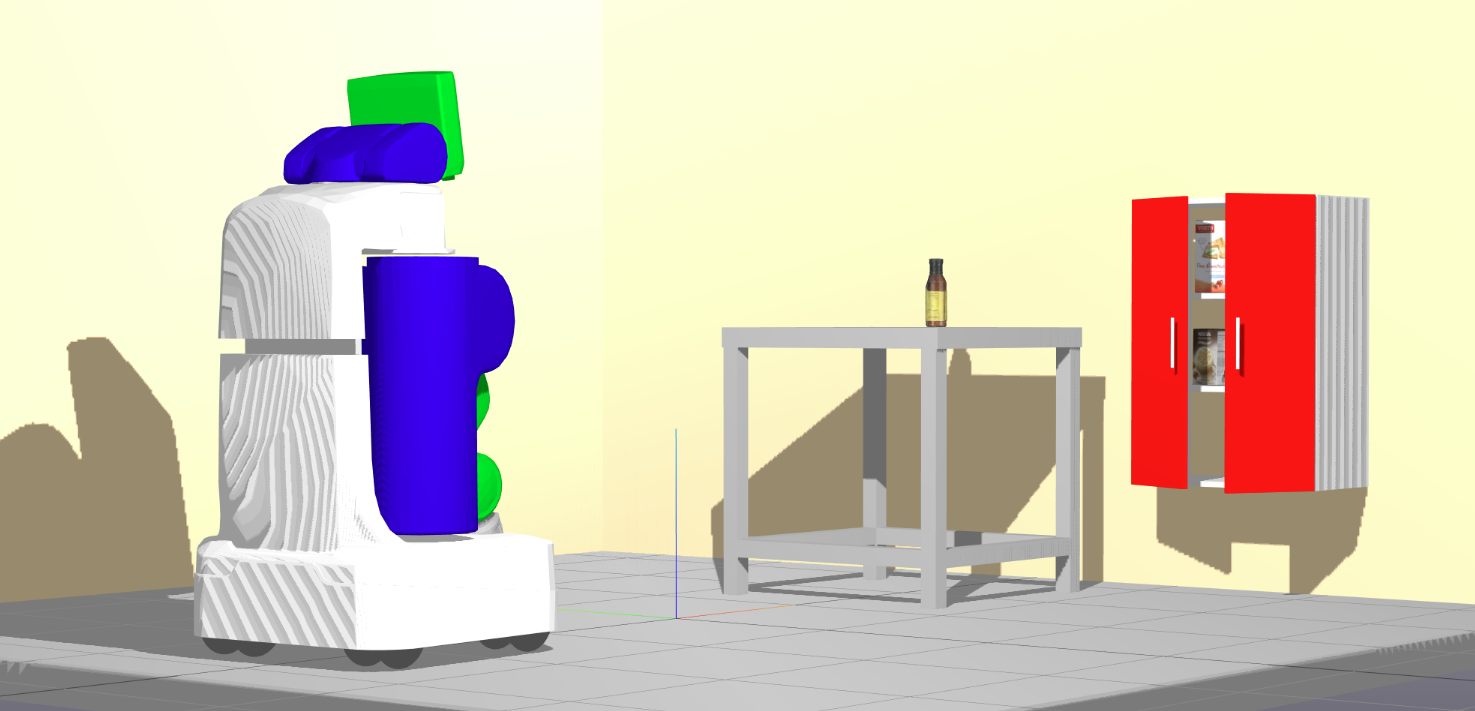Environment generation tool using attributed stochastic scene grammars.
See examples/kitchen for a demo of programmatically specifying a grammar
and using it to generate scenes.
Scenes are described by a set of symbol definitions (equiv. "node" types, representing objects and hierarchical groupings of objects) and rules (which describe how to take a nonterminal node and generate more nodes from it). A node gets to sample a set of active rules to determine what gets generated, while each rule dicatates where (among other continuous choices) things get placed.
Concretely, nodes are Python classes that contain information about the details of the node (e.g. its pose, geometry, and style). Nodes can be Terminal or Nonterminal; nonterminal nodes lead to no further children, while Nonterminal nodes have additional interface to describe how they generate children. Specifically, nonterminal nodes contain a list of rules that originate from that node, and a way to randomly sample a set of active rules to generate children from the node. There are a provided set of typical node types:
- AND nodes use all of their rules all the time, OR nodes use exactly one of their rules at random, and SET nodes choose different combinations of rules in more complex ways.
A number of Node class mixins are available to provide additional common functionality: the most important being
SpatialNodeMixin, which specifes that the node type will have a pose.PhysicsGeometryNodeMixin, which specifies that the node will have physics and geometry information attached, and allows registration of that geometry in a format to make interop with my physics engine of choice ((Drake)[drake.mit.edu]) easy.
Rules are implemented as Python classes that provide a method for constructing a child node [or set] given the parent. A set of template rules are provided that describe the most common relationships used in grammars:
- Deterministic and Normally-distributed relative placement rules that place a child object at some position in the frame of the parent.
- (More to be implemented as needed.)
I haven't written a general interface for these yet, but demonstrate some ad-hoc constraints that I rejection sample
through in examples/kitchen/run_grammar.py.
A node with PhysicsGeometricNodeMixin can have "clearance geometry" registered alongside
its normal visual and collision geometry. This is intended to represent the volume of space that
that node alone should occupy. A scene satisfies a clearance constraint if all the clearance
geometry of the scene is not penetrating. (This is demonstrated in the kitchen example.)
Not done at all yet. My intent is to be able to specify "container" nodes whose children can all be asked to specify this constraint alongside containment in the container node volume: this would mean, in practice, that I can check / try to achieve physical feasibility for each shelf, box, etc. independently of the rest of the scene. (Easier to make one shelf feasible at a time than do them all simultaneously.)
All random sampling used throughout the grammar spec is done with (Pyro PPL)[http://pyro.ai/] primitives. For grammar writing, this generally means having to write your random sampling like
import pyro.distributions as dist
value = pyro.sample("variable_name", dist.distribution(<dist params>))
where the distribution is from this set of distributions. Variable values throughout the grammar should be torch tensors so autodiff gets carried through.
I suspect / hope I can leverage Pyro's rapidly expanding library of inference routines -- as well as generally taking advantage of gradient info -- to make scene parsing and sampling under relatively amorphous, PPL-specified constraints work. I acknowledge it's a pretty painful startup cost, though.
I try to stay close to Drake model directives format,
but with a few additions. So a scene can be saved out to a YAML file (using
serialize_scene_tree_to_yaml_and_sdfs from drake_interop.py), which will produce
an output package (as a directory), with a package.xml file, SDFs with any
primitive geometry, and a top-level YAML file specifying what model files (including
ones potentially from other packages) are included at what poses.
YAML spec:
- TODO write this down
From pip or conda:
numpymatplotlibnetworkxpyroandpytorchmeshcat
Not on pip yet:
pydrake: Install from here.
Grammar setup:
- Is the complicated node / rule responsibility split worth it? It feels messy / wrong right now -- I want to enforce separation of continuous and discrete decision making, but not really for any reason. That template rules exist and work is sort of nice, but there might be a cleaner way.
- Same for the class mixin nonsense -- maybe I could get away without it, and just commit all of that functionality into the base Node type (and have the system be intelligent about it being used vs not used). Right now, it leads to nasty multiple constructor calls that are going to be super easy to screw up, and lead to confusing bugs.
- Prior work is usually using attributed AND/OR/SET grammar. I'm currently being more flexible by allowing more node types to be created and not forcing SET nodes to be composed out of AND and OR nodes. This complexity might come to bite me when it comes time to write a reversible jump proposal generator...
- General way of specifying constraints would be nice.
- Currently demonstrating sampling with rejection sampling (in kitchen example). Next versions should be:
- Spiral 1: HMC in constraint null space, something like this?
- Spiral 2: Alternate that with tree resampling / parsing?
- Need tree parsing first pass to figure out pain points in interop between the tree structure and Pyro.

